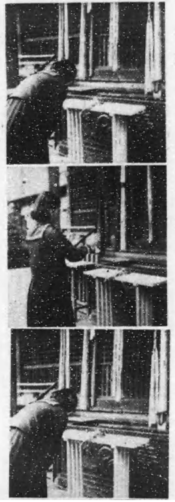Two bows, two claps, one bow
Script error: No such module "Draft topics".
Script error: No such module "AfC topic".


Two bows, two claps, one bow is a practice done when entering a shrine in Japan..[1][2][3][4][5][6]
In Japan, visiting a shrine is an important cultural and spiritual activity, and proper etiquette is followed to show respect to the gods. One of the most familiar forms of this etiquette is "two bows, two claps, one bow,"[7]
There are various historical systems but this is the current one now[8]
This is considered the standard among shrines[9] However local variations exist[7]
It is sometimes called 2-2-1[10]
Procedure[edit]
Worship ettiquette goes as follows[11][12]
- Bow once before entering Torii[11][12][3]
- Purify hands and mouth with chozuya[11][12][3]
- Put money in the offering box[13][3][7]
- Ring the bell 2-3 times if present[14][7]
- Bow twice[11][12][3] [7]
- Clap twice[11][12][3] [7]
- Bow once[11][12][3] This bow should be deeper than the others[15] at a 90-degree angle[7]
simple:Two bows, two claps, one bow
History[edit]
Hakushu or ceremonial clapping has a long history in Shinto[16]
It has a long history in Japan The Wajinden describes the people of the Yayoi period as clapping in worship.[17]
Some people considered it to Buddhist meaning with the right hand meaning Buddha and the left hand meaning all beings so unification of Buddha and all beings[18] As Buddhism and shinto have been together for so long it is unclear which one it originated from[19]
However the the origin of the modern "two bows, two claps, one bow" etiquette can be traced back to the "Shrine Festival" in 1873, where it was written as "revisit applause." Over time, various methods were devised and improved, leading to the creation of the current etiquette. The "Shrine Rituals and Events Etiquette" enacted in the 40th year of the Meiji era defined the etiquette as "returning, clapping twice, pressing together, praying, praying, clapping twice, and bowing again."[7]
It is widely accepted that "two bows, two claps, one bow" is the formal etiquette of worship for the chief priest. The etiquette was created through the long experience and improvement of the predecessors and is a reflection of the respect for the gods.[7]
See Also[edit]
References[edit]
- ↑ https://archive.ph/wip/h8HxU
- ↑ "How many times should you bow and clap at the shrine? (Tips #2)". Akemi's Blog. Retrieved 2023-04-08.
- ↑ 3.0 3.1 3.2 3.3 3.4 3.5 3.6 3.7 "How to worship correctly at temples/shrines [with images] | Living in JAPAN". Living in JAPAN | Living in Japan is a web magazine dedicated to foreign nationals. We provide a lot of useful information such as Japanese culture and manners to navigate life in Japan. We also provide job hunting and VISA support. 2019-05-23. Retrieved 2023-04-08.
- ↑ D, John (2019-02-17). "First steps in Shinto". Green Shinto. Retrieved 2023-04-08.
- ↑ "The Basics of Shrine Visiting! Must-Know Information and Some Recommended Shrines in Japan". The KANSAI Guide - The Origin of Japan, KANSAI. 19 October 2021. Retrieved 2023-04-08.
- ↑ "American Shinto Community of Practice: Community Formation outside Original Context - ProQuest". www.proquest.com. Retrieved 2023-04-08.
- ↑ 7.0 7.1 7.2 7.3 7.4 7.5 7.6 7.7 7.8 "二礼二拍一礼は参拝の基本。その歴史と考え方とは。|葬儀・家族葬なら【よりそうお葬式】". www.yoriso.com (in 日本語). Retrieved 2023-02-11.
- ↑ Wanderingmonk19 (2017-07-13). "Shinto Manner of "Two Bows, Two Claps and One Bow" Set as the Standard by God's Will". ISE-HAKUSAN DOU'S "THE UNIVERSE". Retrieved 2023-02-12.
- ↑ "ETIQUETTE'S AT SHRINES". Hello! Tokyo Tours. 23 July 2020. Retrieved 2023-02-12.
- ↑ Bagarino, Christine (2018-03-15). "How to Pray at a Japanese Shinto Shrine". Culture Trip. Retrieved 2023-02-12.
- ↑ 11.0 11.1 11.2 11.3 11.4 11.5 "Do you know? Shrine manners and their meanings | Feel Fukuoka Japan". 2015-08-21. Retrieved 2023-02-12.
- ↑ 12.0 12.1 12.2 12.3 12.4 12.5 12.6 https://archive.ph/wip/kcBD3
- ↑ "Learn about Shinto - How to behave in a shinto shrine". 供TOMO ONLINE STORE. 7 June 2021. Retrieved 2023-02-12.
- ↑ Japanistry (2016-11-06). "Visiting Shrines & Temples in Japan: Etiquette & Customs". japanistry.com. Retrieved 2023-04-08.
- ↑ "Pray|Ise Jingu". Ise Jingu. Retrieved 2023-02-12.
- ↑ "Encyclopedia of Shinto詳細". 國學院大學デジタルミュージアム (in 日本語). Retrieved 2023-03-11.
- ↑ https://en.wikisource.org/wiki/%E9%AD%8F%E5%BF%97%E5%80%AD%E4%BA%BA%E4%BC%9D
- ↑ "Why are the hands clapped when praying at shrines (Shintoism) and placed together when praying at temples (Buddhism)? Online Atlas english school. Teaching jobs in Osaka,Sapporo,Yokohama,Nagoya,Kyoto,Kobe". atlasp.net. Retrieved 2023-02-12.
- ↑ "Why do some Japanese people clap their hands when they pray for something at the temple?". GoWithGuide by Travelience. 2013-04-14. Retrieved 2023-02-12.
This article "Two bows, two claps, one bow" is from Wikipedia. The list of its authors can be seen in its historical and/or the page Edithistory:Two bows, two claps, one bow. Articles copied from Draft Namespace on Wikipedia could be seen on the Draft Namespace of Wikipedia and not main one.
